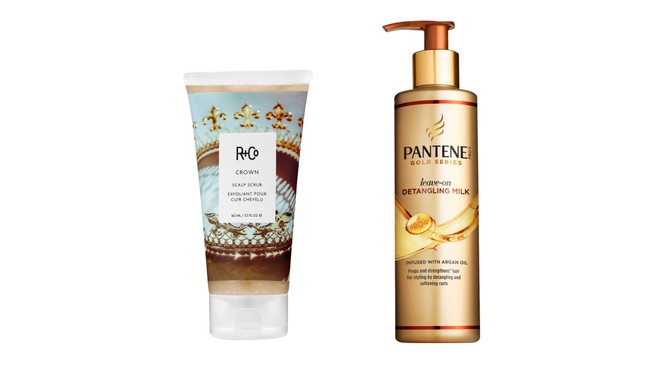5 Hair Types No One Talks About (and How to Deal With Them)
Oily and dry, gray and dyed, natural and relaxed—whatever your hair combo, these expert tips will restore harmony.
By Melissa Goldberg
Natural Roots + Relaxed Ends
Both of these textures need serious damage control. "When you chemically straighten your curls, you're manipulating your hair's chemical bonds, making it prone to breakage," says Wilkerson. "Not to mention that every time your natural hair curls, bends, or twists, the protective cuticles are uplifted, weakening the strand."
Wash: While you may be tempted to go a week between shampoos, you should aim to wash every three days. "If you're not cleansing your scalp regularly, oil and dead skin cells accumulate, which can lead to flaking, itching, and eventually even hair loss," says Kingsley. Plus, a healthy scalp nourishes the hair follicles, so they'll produce stronger, thicker strands. Apply a scalp exfoliator to help remove buildup, and follow with a hydrating shampoo and conditioner. (Look for moisturizing humectants, like glycerin, and natural oils, like avocado.) For extra moisture, you can also add a mask twice a week. R+Co Crown Scalp Scrub, $38; RandCo.com
Treat: Post-shower, use a detangler. The leave-in treatment smooths the hair shaft, so it's less likely to build up friction and form knots—both of which can lead to more damage, says Wilkerson. Pantene Gold Series Leave-On Detangling Milk, $8; drugstores.
Style: The easiest way to create uniform curls? Use rod sets, which are flexible, foam tubes in various sizes. (To pick the correct one, choose the thickness closest to the curl size of your new growth, says Matrix artistic director Michelle O'Connor.) Keep it heat-free, and therefore damage-free, by wrapping one-inch sections of wet hair around each rod and allowing them to set overnight.
Wash: While you may be tempted to go a week between shampoos, you should aim to wash every three days. "If you're not cleansing your scalp regularly, oil and dead skin cells accumulate, which can lead to flaking, itching, and eventually even hair loss," says Kingsley. Plus, a healthy scalp nourishes the hair follicles, so they'll produce stronger, thicker strands. Apply a scalp exfoliator to help remove buildup, and follow with a hydrating shampoo and conditioner. (Look for moisturizing humectants, like glycerin, and natural oils, like avocado.) For extra moisture, you can also add a mask twice a week. R+Co Crown Scalp Scrub, $38; RandCo.com
Treat: Post-shower, use a detangler. The leave-in treatment smooths the hair shaft, so it's less likely to build up friction and form knots—both of which can lead to more damage, says Wilkerson. Pantene Gold Series Leave-On Detangling Milk, $8; drugstores.
Style: The easiest way to create uniform curls? Use rod sets, which are flexible, foam tubes in various sizes. (To pick the correct one, choose the thickness closest to the curl size of your new growth, says Matrix artistic director Michelle O'Connor.) Keep it heat-free, and therefore damage-free, by wrapping one-inch sections of wet hair around each rod and allowing them to set overnight.
From the November 2017 issue of O, The Oprah Magazine


